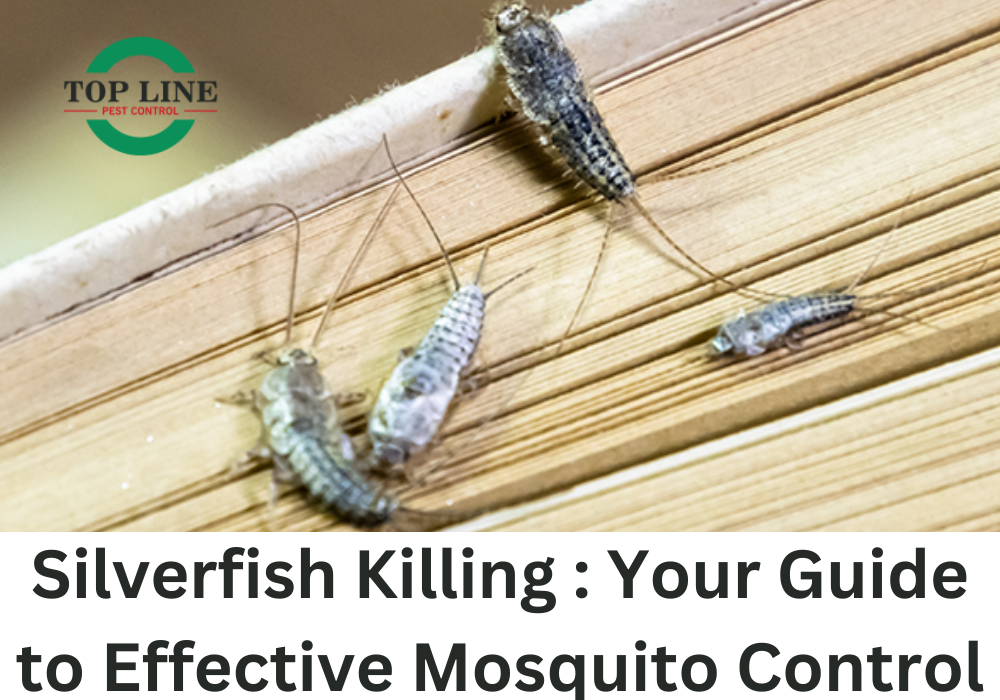Tiny issues can pose serious threats to your livelihood. Silverfish are tiny, but they have the potential to bite through felt, paper and even fabric. They spread significantly, wreaking an irritable havoc on your day-to-day life. Your concerns are at an end because you can eject these unwelcome visitors and reclaim your house by using effective Silverfish Pest Control methods given below.
Mosquito Control – Overview
Silverfish thrive in bathrooms, basements and any dark, cold spaces. They feed on sugar, proteins and carbohydrates found in common household goods like cereal, books, and clothes. Their ability to squeeze into small areas and nocturnal habits make them difficult to locate and eradicate.
Detection is the initial stage of silverfish pest management. Look for small, silvery insects with long bodies and antennae about half an inch long. Look for signs of activity in dark, damp areas under sinks, behind baseboards, and drawers, including spilled leather and small black spots of dirt.
Prevention: The Best Solution for Silverfish Control
Preventing a silverfish infestation is the most effective and long-lasting approach to pest management. Since silverfish thrive in moist, damp environments, controlling the humidity in your home is key to stopping an infestation before it begins. Here are some important steps to prevent silverfish from taking over your home:
- Control Moisture Levels: Silverfish are drawn to damp conditions, so it’s essential to maintain proper airflow and ventilation throughout your house. Ensure areas prone to moisture, like basements and bathrooms, are well-ventilated. Consider using dehumidifiers or installing exhaust fans to lower humidity levels.
- Seal Entry Points: Silverfish can enter your home through small cracks and gaps, especially in doorways and around windows. Inspect your home for these entry points and seal any gaps with caulk or weatherstripping to prevent silverfish from gaining access.
- Food Storage: Silverfish are attracted to food sources, particularly starchy substances like paper, glue, and dry food. Store food items in airtight containers and make sure pantry shelves are clean and free of crumbs. Likewise, keep paper materials such as books, magazines, and documents stored securely to avoid attracting silverfish.
- Remove Hiding Spots: Silverfish are nocturnal creatures that prefer dark, quiet spaces. By reducing clutter in your home, especially in areas such as closets, basements, and attics, you make it harder for silverfish to find suitable hiding spots.
Therapeutic Options for Silverfish Control
While prevention is critical, it’s important to understand that silverfish infestations may sometimes require more direct action. If you are already dealing with a silverfish issue, there are various treatments available to eradicate them from your home.
- Chemical Treatments: Chemical insecticides can be highly effective in killing silverfish. When using chemicals, choose insecticides specifically formulated for silverfish control. Always read and follow the manufacturer’s instructions carefully, as incorrect usage can be harmful. Apply the insecticide in potential hideouts such as cracks, crevices, and dark corners where silverfish are likely to hide.While chemical treatments are effective, it’s important to note that some may require you to vacate the treated areas temporarily to avoid exposure. Planning ahead ensures that you can treat your home while minimizing risks to family members and pets.
- Natural and Non-Toxic Alternatives: For those who prefer eco-friendly solutions, there are several non-toxic alternatives available. Diatomaceous earth, for example, can be sprinkled in areas where silverfish frequent. This natural substance is harmless to humans and pets but lethal to insects, as it dehydrates them. Essential oils like lavender and cedarwood are also known to repel silverfish, offering a more natural way to deter them from your home.
Seek Professional Assistance for Persistent Problems
If you have tried preventive measures and therapeutic options but still struggle with silverfish infestations, it may be time to seek professional assistance. Pest control experts have the necessary knowledge, experience, and tools to handle even the most stubborn silverfish problems.
Professional pest control technicians can provide a comprehensive inspection of your property to identify the root causes of your infestation. They will use advanced techniques and tools to eliminate silverfish from your home and implement long-term solutions to prevent future infestations. Additionally, experts can treat large areas more effectively and safely than DIY methods, ensuring thorough eradication.
Professionals may also provide advice on how to improve your home’s ventilation and moisture control to prevent future pest issues. If you’re dealing with a recurring infestation, expert help ensures a solution that’s tailored to your specific situation.
Wrapping Up: Silverfish Control Made Simple
Dealing with a silverfish infestation doesn’t have to be complicated or frustrating. By taking proactive steps to prevent moisture buildup and sealing potential entry points, you can keep silverfish at bay.
If an infestation occurs, there are plenty of effective treatment options, ranging from chemical insecticides to natural remedies. However, for persistent issues or large-scale infestations, contacting a professional pest control service can save you time and hassle while offering guaranteed results.
FAQs
What are silverfish, and why are they a problem?
Silverfish are small, nocturnal insects that thrive in moist, humid environments. They are often found in basements, bathrooms, and kitchens. Silverfish can be a problem because they feed on starchy materials like paper, glue, and fabric, leading to damage in books, wallpaper, and clothing. They can also create an unpleasant sight in your home.
How do I prevent silverfish infestations?
To prevent silverfish from entering your home, control moisture by ensuring proper airflow and ventilation, especially in damp areas like bathrooms and basements. Seal cracks and gaps in doorways and windows, store food in airtight containers, and remove clutter to eliminate hiding spots. Regular cleaning can also help reduce food sources for silverfish.
What are the signs of a silverfish infestation?
Common signs of a silverfish infestation include seeing the insects themselves, discovering small holes or damage in paper, books, or clothing, and finding yellow stains or scales that resemble flakes of skin. You may also spot silverfish tracks or droppings around dark, damp areas of your home.
How can I kill silverfish in my home?
Chemical insecticides can be highly effective for killing silverfish. Look for products that are specifically formulated for silverfish control. Apply them to potential hiding spots, such as cracks, crevices, and corners. Alternatively, natural solutions like diatomaceous earth or essential oils (such as lavender or cedarwood) can be used as non-toxic repellents.
Are chemical treatments safe to use around children and pets?
Chemical treatments can be safe when used correctly, but it’s important to follow the manufacturer’s instructions closely. Some insecticides may require that you vacate the treated areas temporarily. If you’re concerned about the safety of chemicals, consider using natural alternatives like diatomaceous earth or consult with a professional pest control service for safer options.




